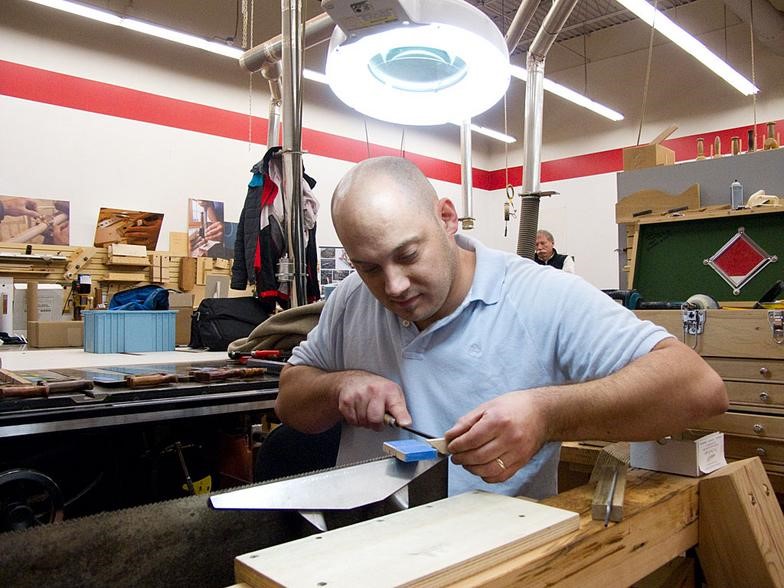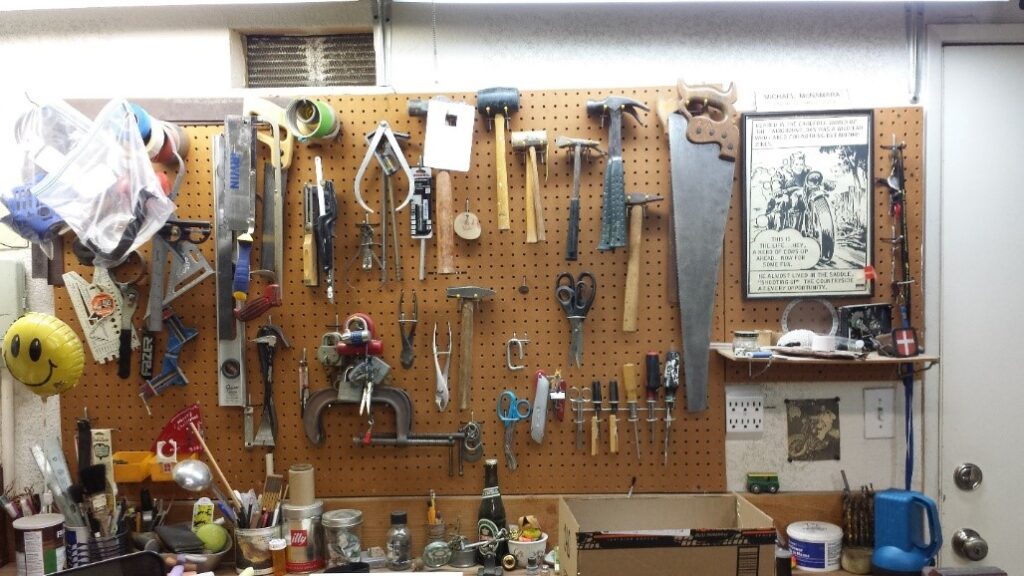PPP – Adolph’s Saw
I love tools and working with my hands. Did this kind of work professionally for the first decade and a half of my post-high school life and my late-in-life return to school for a college degree.
On the walls and in the cabinets of my garage are an assortment of tools that I have collected over a lifetime. In addition to their practical worth, some of them also have great sentimental value. Many of the tools I have originally belonged my Dad or my wife’s Dad. Some of these were no doubt tools that have been handed down to these Dads from other generations. One of these is an old saw. This one saw, that was a part of my Dad’s tool collection, has the initials “AM” carved into the wood handle.

When we were kids my brothers and I would run amok in my Dad’s garage. Having no formal instruction, we would get into his tools and invariably misuse them, and we would cause as much damage to the tools and materials we were working on as we would create things with them. We had no appreciation for what was new and what was old, and the importance of knowing the difference. The three of us learned through experimentation, but the aftermath often looked more like the work product of three gremlins. So, it’s a miracle that decades later, when this saw came into my possession and I realized that this saw was a family heirloom, that it was not completely destroyed.
The “AM” was a clue, and I wanted to know more. There were really only two possibilities; August or Adolph Matthiensen. Internet research led me to a 1937 saw catalog that provided some information, but not enough to tell its true vintage. The saw looked pretty good, but the teeth were so worn that it could not cut through a soft pine two-by-four.
The Saw Wright
Some years ago, I decided I would look for a company that might be able to sharpen it. Those I did find were only in the business of sharpening large industrial blades or power saw blades. It seems we live in an age where buying a new hand saw was preferable to sharpening old ones. By luck and a determined deep internet search, I eventually found one of the rarest of things in this day and age; a saw wright.
Matt Cianci, of Warwick, Rhode Island, started out as a social worker and luthier, which led him to working on saws. He loved it so much he eventually quit his job and became a full-time saw wright. Not only does he repair and restore saws, he also builds them from scratch, and teaches classes on making saws at a local college.
I sent him an email with photos of my saw and asked if he could restore it. I also asked if he could tell me a bit more about the make and vintage of the saw, so I could better determine whether it originally belonged to August or Adolph.


He wrote back,
“Judging from the from the medallion I can say that your saw was made by the Atkins company in their Sheffield Saw Works in Indianapolis, IN. The ‘Sheffield’ moniker was purely for marketing. The Atkins giveaway is the capital ‘A’ in the center of the medallion. The saw was likely made around 1930 or so…def sometime between the two wars. As for work, it looks like it needs heavy jointing and reshaping of the toothline, which will require reshaping of the individual teeth as well. As for the handle, a gentle cleaning, oiling and waxing should bring back much of its charm. You’re looking at the $150 to $250 range likely for the work.”
“When it’s done it should be in top form and be a nice saw to use. I can’t say for sure without handling it, as kinks and bows in the saw blade could prove otherwise, but it looks decent from this vantage point.”
“Let me know if you’d like to send it along and if you have other questions.”

Photo of Matt in his shop.
With this information I think it would be safe to say that it originally belonged to my great-grandfather, Adolph Matthiensen. While Matt says 1930, I’m going say it was earlier, simply because in 1930 Adolph was 58 years old, living at Harry Schneckloth’s place on Thomas Street and working as a car mechanic. I wonder if Adolph had in fact acquired this saw back in 1910 when he was a hardware salesman and was living in a home where such a tool would have come in handy. But perhaps that was too early for this vintage of saw. Then again, back in 1930, wood parts were not uncommon on the cars back then, so maybe it was a shop tool for Adolph. Whatever the case, we can be pretty sure that this was Adolph’s saw.
You can get a vintage hand saw on eBay for about $15.00. Very good new hand saw will go for under $200.00. There are some rare vintage collectables that go up to $900.00, but this saw is not one of them. Nevertheless, I sent Matt the saw, and it ended up costing around $300.00.
The Finished Product

Matt is a true craftsman. It took several months (he had other projects), but when I got it back it was beautiful! This old saw, now about 100 years old, still has the patina of a vintage saw, but it cuts like it is brand new. In fact, it is so sharp that if I go to grab it off the wall, I have to be careful not to touch the blade because it will cut the skin with just a brush of the hand. To me, doing this was a homage to Adolph and my Dad. It was worth every penny.
For my Dad to have had possession of this saw, it would have had to been passed down from Adolph (Hilda’s Dad) to Mac (my Dad’s Dad), then to me. And along that chain of ownership, it would have traveled from Iowa to California. Of all the things that they packed-up in 1937 to come to California, this saw was one of them. I also have a very old well-worn screwdriver that I’m pretty sure is as old as this saw as well.

This saw is more than just an old tool. To me it is a symbol of family and the labor of love that comes with manual labor, and keeping house and home. I hope that one day when I am gone that it will get passed on and stay in the family.
MMc
No Comments yet!